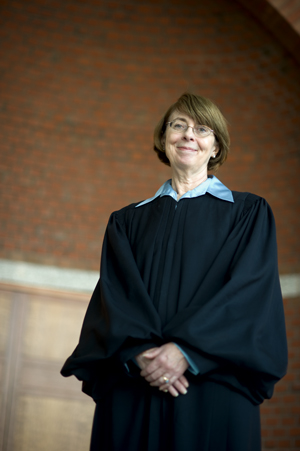The First Circuit’s First Woman
Sandra Lynch (LAW'71) on breaking new ground for women, at BU and on the bench

Late one night,when the tourists had returned to their hotels and the streets of IslaVerde, Puerto Rico, were all but deserted, a young woman stepped out ofher car, and a man’s voice immediately ordered her back in. The man,holding a knife, forced her to drive to a deserted beach, where hebrandished a gun and raped her. Sometime later, when the police foundthe woman running along the road frantically waving her arms, she wasso traumatized she could not speak.
The weapon-wieldingassailant was convicted of carjacking, and 10 years were added to hissentence because the crime involved serious bodily injury. But when thecase was appealed, the 10-year premium was dropped. A three-judgepanel of the First Circuit Court of Appeals found that under statutorydefinition, rape was not a serious bodily injury.
A petitionfor a rehearing was filed with the full six-judge Court of Appeals, andone of its members, a woman relatively new to the court, read thepanel’s opinion and wrote the following: “The victim was taken to aremote beach by a man with weapons, forced to strip, and then raped. Tosay that this testimony provides ‘no record of support’ for a findingthat the attack on the victim involved extreme physical pain ignoresthe reality of what she went through.”
“Congress,” she went on to write, dissenting from the court’s denial of the rehearing, “would be appalled at this outcome.”
As it turned out, the Honorable Sandra L. Lynch was right. Congresswas appalled. Lynch’s dissent caught the attention of a congressionalstaffer, also a woman, who persuaded a legislator to author a billmaking it clear that the term “serious bodily injury” includes rape.
“Apparentlythe bill flew through both houses in two weeks,” says Lynch (LAW’71).“I thought it was lucky that there was a woman staffer in Congress whosaw the issue the way I did and had the willpower to bring it up.”
Atthe time, in June of 1996, Sandra Lynch was the only woman serving onthe First Circuit Court of Appeals and the only woman who had ever served on it. Lynch had arrived on the bench 13 months earlier,chosen by President Bill Clinton to fill the seat vacated by newlyappointed Supreme Court Justice Stephen Breyer (Hon.’95).
ForLynch, the appointment was another in a string of career firsts. Shehad been the first woman to clerk for a federal judge in Rhode Islandand the first woman to head the litigation department at the Boston lawfirm Foley, Hoag & Eliot. And now there is another first. LastJune, she became the first woman to serve as chief judge of the FirstCircuit Court.
Michael Keating, a friend and former colleagueat Foley Hoag, as the firm is now called, recalls the scene at Lynch’sinduction into the federal judiciary: “When you looked at the lineup ofnew judges, it looked like the first tee of a golf club. There were allthese old white guys. And there was Sandy.”
In her new role,Lynch heads a court that handles appeals in civil and criminal casesfrom federal district courts in Maine, New Hampshire, Massachusetts,Rhode Island, and Puerto Rico. She is also responsible for thedispensation of misconduct complaints against 75 federaljudges — a task, says former chief judge Michael Boudin, that can involve“painful issues and painful relationships.”
Lawyers who appearin Lynch’s court describe her as no-nonsense, a jurist who knows herfacts cold, whose opinions are not colored by ideology. Her decisionshave overturned a jury verdict ordering Massachusetts General Hospitaland one of its brain surgeons to pay $8 million to the families ofbrain tumor patients who died after receiving experimental treatmentdecades ago. (In that case, Lynch found that testimony against thehospital was based on research published after the patient experimentswere completed.) They have denied requests for a new trial byplaintiffs who claimed that a Cape Cod wind farm was built withoutproper oversight by the state. (In that case, the court found that thestate had no authority over federal waters, which begin three milesfrom shore.) And they have ruled that a Lexington, Mass.,parent cannot sue the town because the high school newspaper refused toprint an ad for sexual abstinence.
“My job isn’t boring,” saysLynch. “It presents very hard problems. We may have a problem that hasimplications for a whole industry or a whole segment of society. Thehardest part is thinking through the ramifications of whateverarticulation of law you come up with, for the next case, the case thatisn’t in front of you. You are worried all the time about whether youhave articulated a rule that makes sense, that will work in the future,and that you haven’t set up a rule that is going to cause injustice orcause irrational results.”
Lynch typically hears about 180cases a year and writes summary dispositions on hundreds more. Hercaseload ranges from ordinary civil cases, such as contract oremployment discrimination, to terrorism cases to death penaltylitigation. The court receives appeals from federal courts and federaladministrative agencies, as well as habeas corpus petitions from stateand federal prisoners, and also some original proceedings.
“Thehardest cases have been figuring out not only what Congress meant,”says Lynch, “but also thinking through the ramifications. If I answerthe question one way, it will have these ramifications; if I answer itthe other way, it will have these ramifications. And very often,Congress uses ambiguous language because it’s the only way it cancompromise and get a bill through. And then it falls to the courts towork out exactly what Congress meant. You really have to enjoy solvingproblems.”
“Judge Lynch is first and foremost pragmatic,” saysAmanda Teo, who clerked for Lynch as a Harvard Law student three yearsago. “She is interested in what makes good law and what would resolvethe dispute for the parties. That allows her to get to the core of acase and actually do good law, which is something that is an accidentalby-product in many courtrooms. And she is, of course, a great rolemodel.”
Lynch’s take on her status as a role model is nothing if notjudicious. “My generation of women is used to being the first,” shesays matter-of-factly. “Sometimes we are the only women in a particularposition of responsibility. So what you find in the first woman role isyou are a symbolic figure, and you know that. Whether you choose to beor not, you are a role model, and so you feel a special burden toperform well. While you might prefer to be modest and not the center ofpublic attention, you end up being the center of public attentionanyway.”
In fact, Lynch has attracted public attention sinceshe was in high school near Dallas, Tex. There, as editor of the highschool paper, she penned editorials decrying the town’s practice ofmaintaining separate drinking fountains for black students and whitestudents. “That was not,” she recalls, “a popular position.”
Lynchsays her childhood as an Army brat, which included long stints in Italyand Germany, set her priorities, placing principles well abovepopularity.
“I had an unusually strong sense of America as aconstitutional democracy, where values like freedom of speech, equalityof opportunity, and fairness under the law were very important,” shesays. “I was raised not only to take on responsibility, but with asense of obligation to one’s country that you needed to use your lifein a meaningful way.”
From Texas, Lynch attended WellesleyCollege and then BU’s School of Law, which she says prepared her well.That preparation was enhanced by a clerkship with U.S. District JudgeRaymond J. Pettine, in Rhode Island. She next served as general counselfor the Massachusetts Department of Education, where she helped to pushthrough a state gender equality law and a special needs statute. Shealso worked as a Massachusetts assistant attorney general, representingthe commonwealth in a school desegregation case against the BostonSchool Committee.
In 1978, Lynch joined Foley Hoag, a firmknown for its absence of an old boy network. She was soon leading thefirm’s litigation practice.
“Sandy is the person you want inthe foxhole with you,” says Keating, who worked with Lynch on thedefense team for chemical company W. R. Grace, a legal battle that isportrayed in the book and movie A Civil Action. “She is smart, diligent, and she never asks anyone to do anything that she wouldn’t do.”
B.J. Trach, an assistant U.S. attorney, who clerked for Lynch four yearsago, believes that Lynch’s years as a litigator made her thedetail-minded judge she is today. “Some judges will have the clerksread the briefs and do a memo to the judges,” says Trach. “Judge Lynchdoes all the prep work herself. She is completely aware of everythingin both parties’ briefs. The benefit for people who argue in front ofher is that they know the work they’ve done is being taken veryseriously.”
The downside for lawyers, says Trach, is that Lynch expects them to be equally prepared.
“Sandy is a very determined person,” says Keating. “She doesn’t suffer fools gladly, in or out of the courtroom.”
Andshe never did. Sitting in her spacious office in the John JosephMoakley United States Courthouse, the chief judge recalls an incidentdecades ago, from her days as a student at LAW.
“In my firstyear,” she begins, speaking with the resolve of someone whoseoccupation demands that her opinions disappoint 50 percent of heraudience, “we had a contracts professor who used the Socratic method.Normally, in any given hour, a professor will call on half a dozenstudents. This male professor called on a female student for the entirehour, not just the first day. He called on her every day for the entirehour. Finally, on Friday, she misunderstood a question and she gave awrong answer. That was what he had been waiting for. He turned to theclass with a look of triumph on his face and said, ‘Well, class, now weknow why women aren’t noted for their beautiful minds.’ At that point,I stood up, very publicly. I closed my books. I looked at the otherwomen in the class, and I led a walkout.”
Lynch pauses. Fromher desk, she can look northeastward, across Boston Harbor and EastBoston and on toward New Hampshire and Maine, the northern reaches ofthe territory whose plaintiffs and defendants end up arguing in hercourt.
“To its credit,” she says, “at a time when many lawschools were admitting 3 or 4 percent women, BU made a commitment toadmit at least 10 percent women. It was a radical idea — to teach womento be lawyers. But the school did reflect the stereotypes of the times.”
Anotherpause, then Lynch continues, “I’m grateful to BU, not just because Iwas admitted, but because it forced me to confront some of theseissues, and I emerged stronger for it. Had I not gone through it, itmight have been harder to have the career I’ve had.”
This story originally ran in the Winter 2008–2009 issue of Bostonia.
Art Jahnke can be reached at jahnke@bu.edu.

Comments & Discussion
Boston University moderates comments to facilitate an informed, substantive, civil conversation. Abusive, profane, self-promotional, misleading, incoherent or off-topic comments will be rejected. Moderators are staffed during regular business hours (EST) and can only accept comments written in English. Statistics or facts must include a citation or a link to the citation.